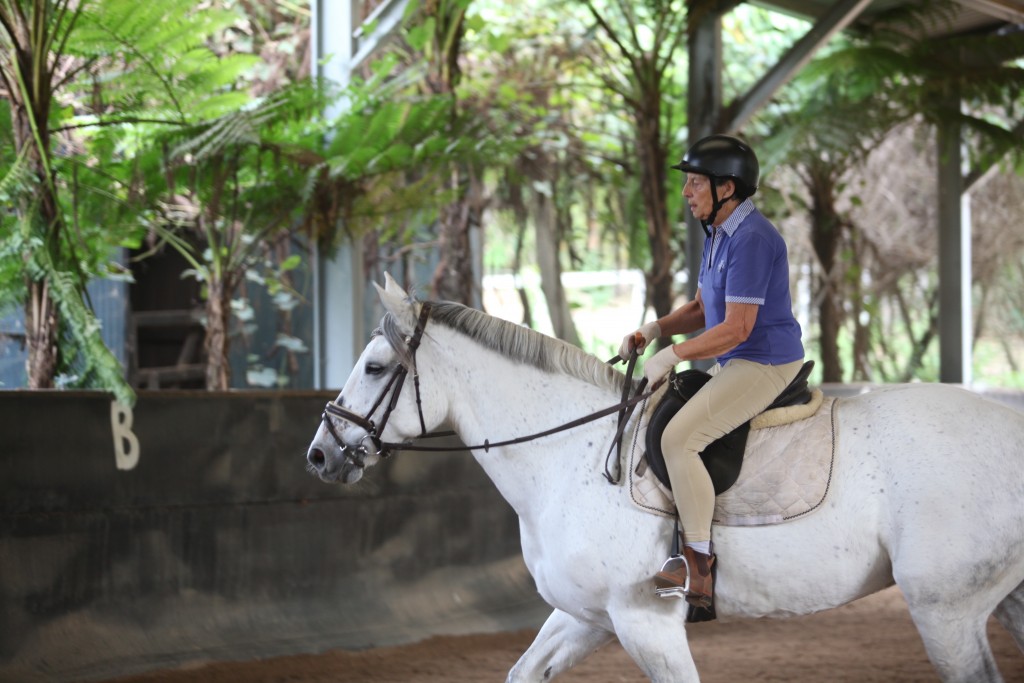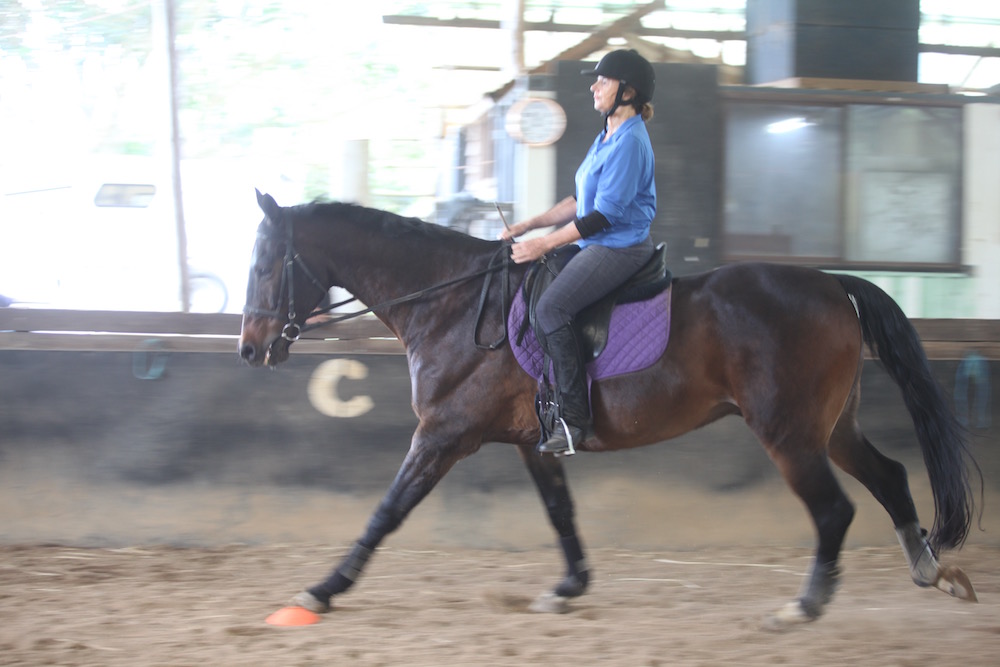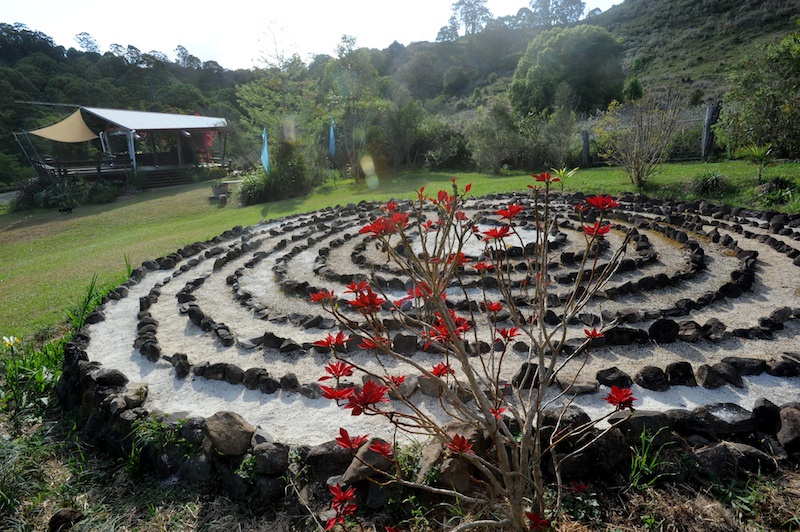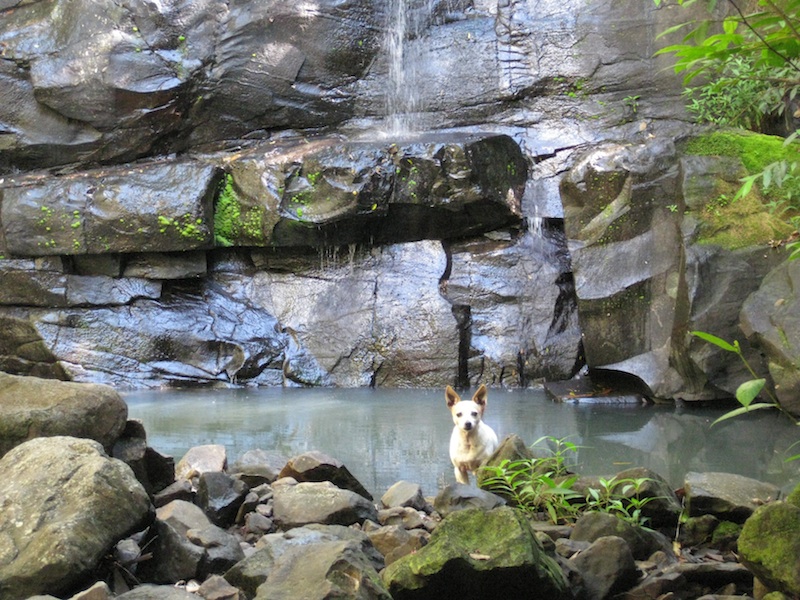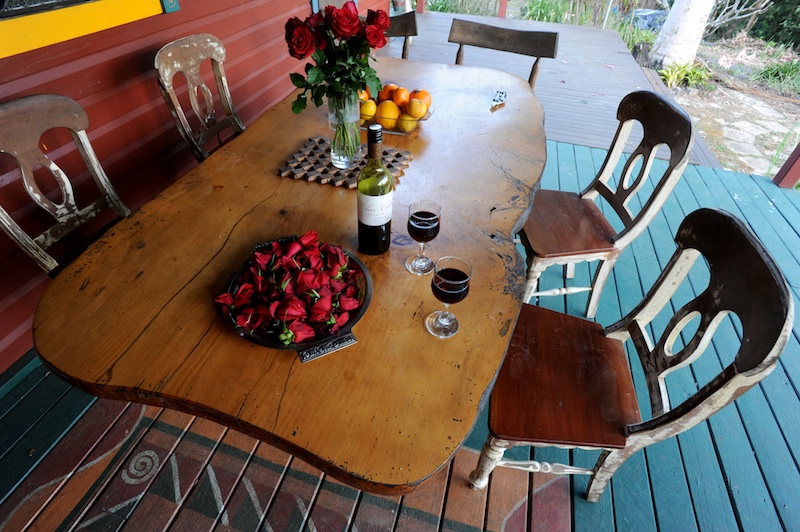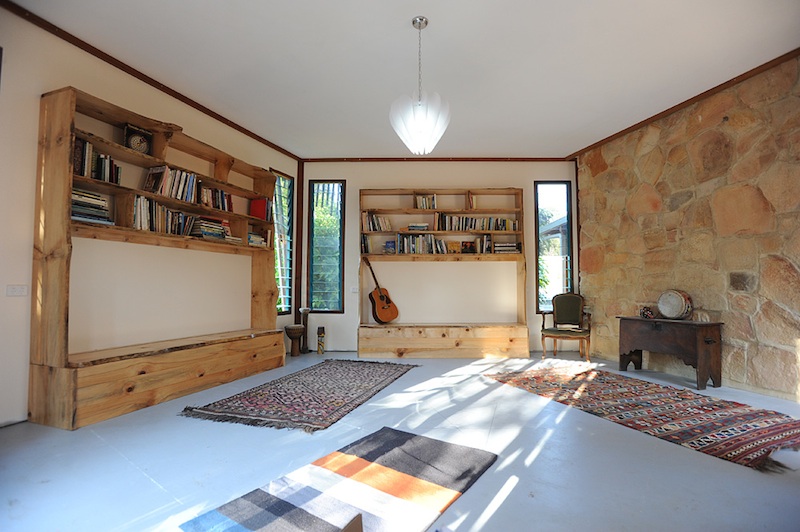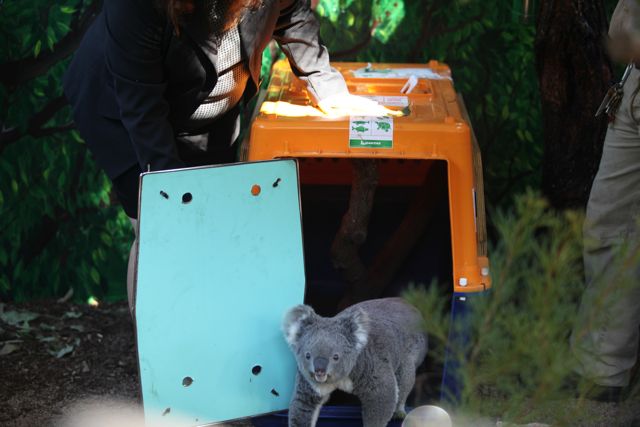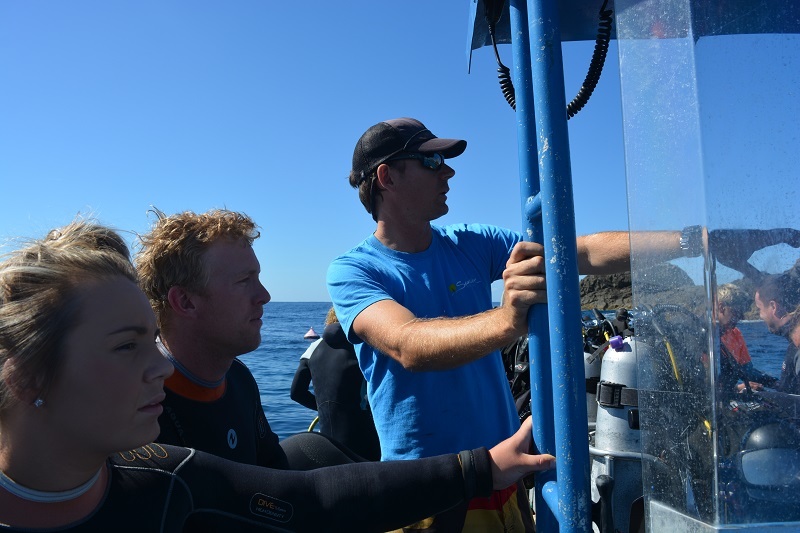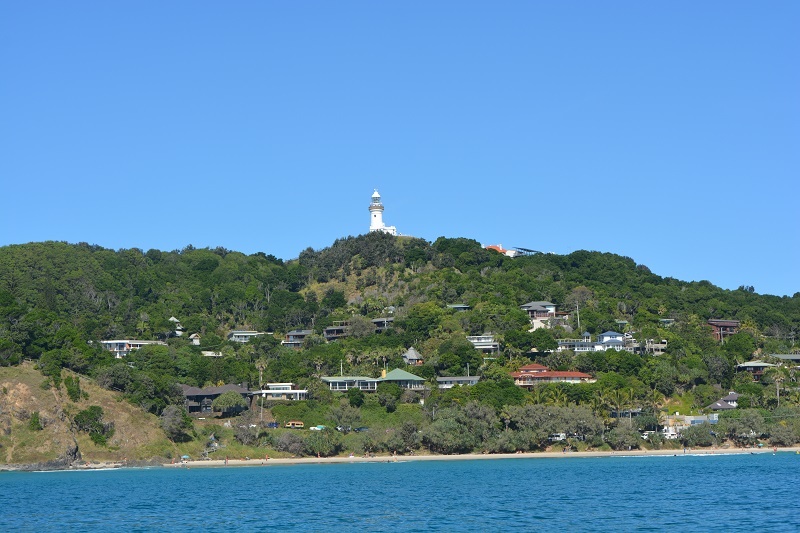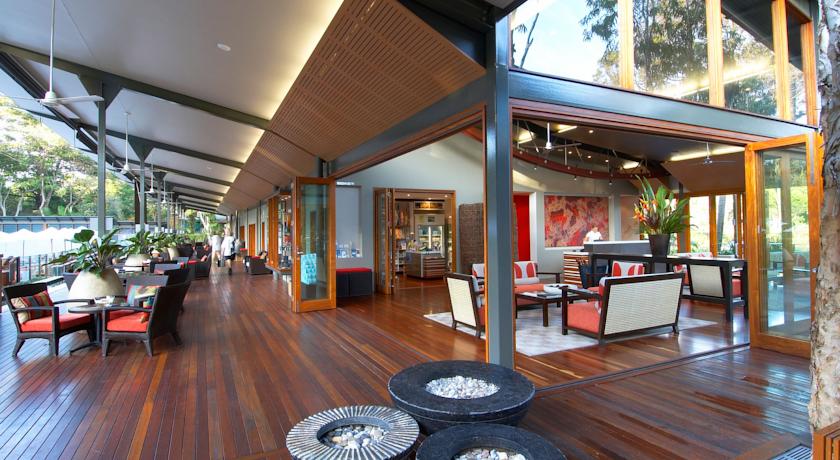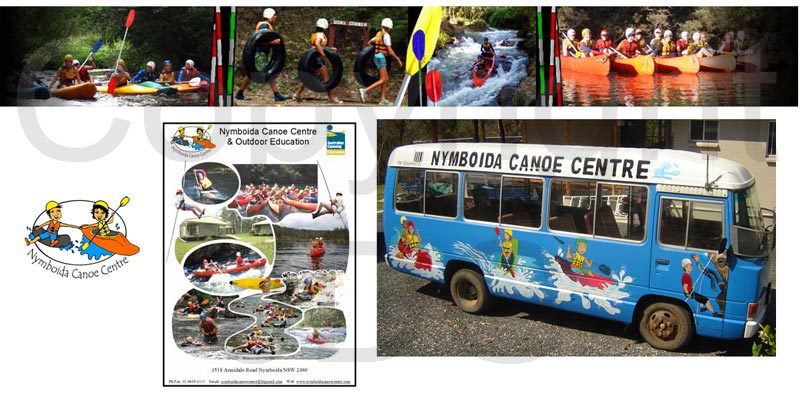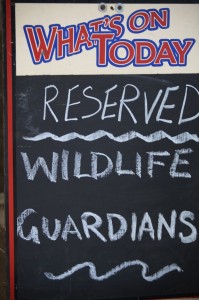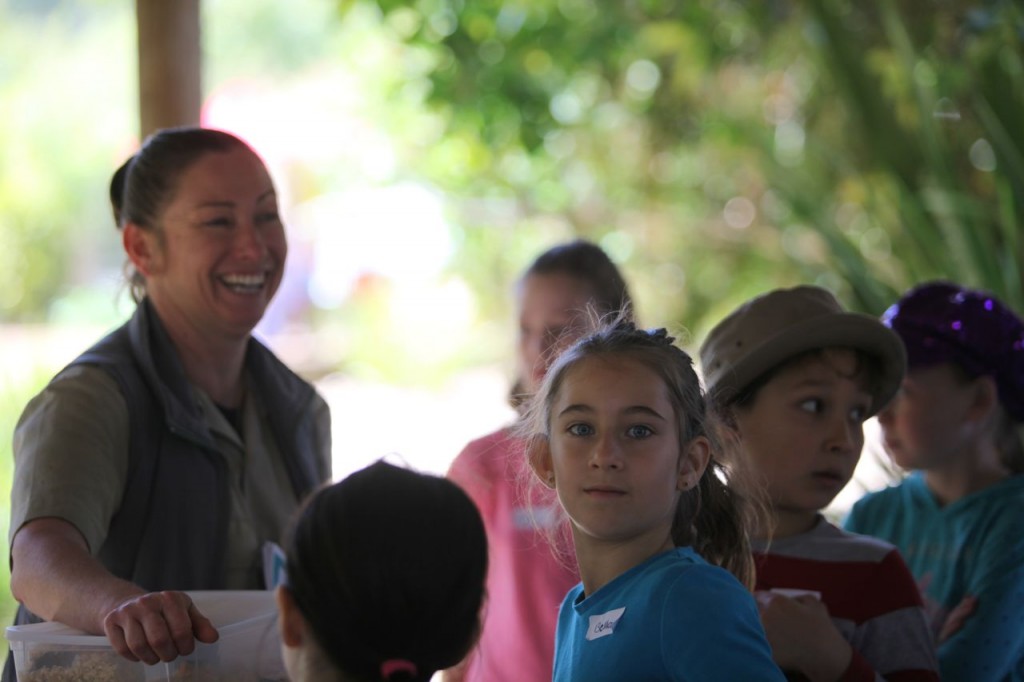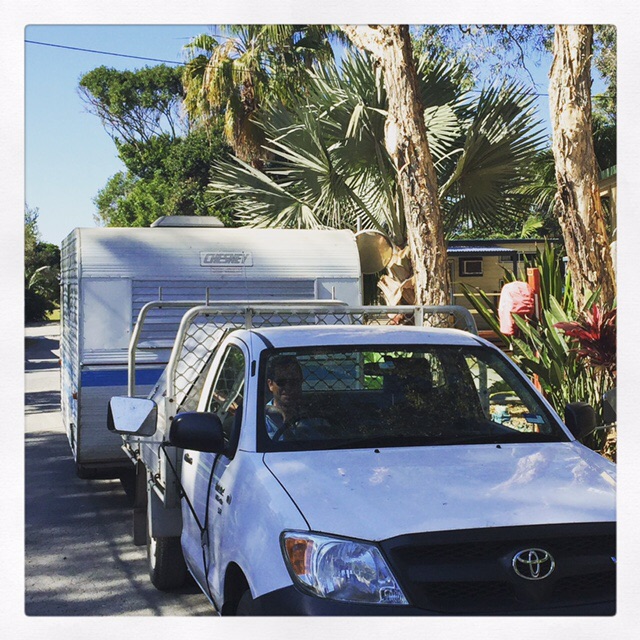The post Byron & Brunswick – they can put their hats on… appeared first on .
]]>Brunswick Heads Fleet has been awarded the title of top regional restaurant in NSW. The scores are in and the results are official – the Byron Shire is home to two of Australia’s top restaurants, with the recently released national Good Food Guide awarding both Brunswick Heads Fleet and Byron Bay’s The Byron at Byron Resort hat status.
The Byron at Byron Resort received one hat, while Fleet received two hats and was the highest scoring restaurant in regional NSW with 17.5/20
The Guide of independent, anonymous reviews is written by a panel of trusted restaurant critics and recognises the best Australian restaurants nationally with ‘hats’, symbolised by a chef’s toque. To secure a coveted spot in the Guide, restaurants in New South Wales and Victoria must score at least 14 out of 20, while all other states must score a minimum of 15.

Neil Perry says his best meal in 2018 was at Brunswick Heads Fleet restaurant which now has two hats.
To achieve a hat is a pinnacle of a chef’s career and a restaurant’s history, with the term ‘hatted’ becoming embedded in the Australian lexicon. More than 500 restaurants from across the country were reviewed for this year’s Guide, with 264 of these receiving hat status, ranging from one to three.
Only seven restaurants nationally achieved the top accolade of three hats, and they include Attica (VIC), Brae (VIC), Momofuku Seiobo (NSW), Minamishima (VIC), Quay (NSW), Restaurant Orana (SA) and Sixpenny (NSW).
The catalogue of influential Guide editors includes founding editors Claude Forell in Melbourne and Leo Schofield in Sydney – along with Terry Durack, Jill Dupleix and Matthew Evans – all of whom have helped shape and chart the growth of the restaurant industry in Australia.
It is this rich 39-year tradition that the 2019 Good Food Guide editor Myffy Rigby upholds, ensuring the Guide remains Australia’s pre-eminent restaurant bible.
“The Good Food Guide is a reflection of the thousands of voices that make Australia one of the most diverse and delicious places to eat in the world,” says Rigby. “The Guide is a celebration of the industry as a whole. Every one of the restaurants featured is a summation of all those moving parts. We recognise the hard work of all those Australian restaurants and everything they do to enrich the scene.”
The Good Food Guide is the perfect Christmas present for those that love to travel and eat!
The national Good Food Guide 2019 is out now and retailing for $29.99.in newsagents and online at: www.thestore.com.au/goodfood
The post Byron & Brunswick – they can put their hats on… appeared first on .
]]>The post 75 – and she’s still tall in the saddle appeared first on .
]]>I feel a bit ashamed of myself to be honest. I think it was about four years ago, in my late fifties, when I began to complain a bit about a slightly arthritic right hip that was preventing me from hopping on and off a horse in quite the style I’d been used to, and I started to talk about whether it was time to give up riding altogether.
But recently I met Janet Edgerton, and I have to say – I’ve been somewhat silent on the subject of riding, and ageing, because at the age of 75 (it was her birthday a few weeks ago), Janet is riding on a weekly basis, and not only that, but she came back to it after a 36-year-break.
I’m standing on the sidelines of the arena at the Byron Bay Equestrian Centre watching Janet and her fellow rider, Beeb Fleetwood, a mere 64, going through their paces on two of Tesse’s most precious horses. Beeb is on, Junior, a somewhat ironically named massive 16.3hh warmblood, and Janet is on Lucy, Tesse’s own personal Percheron.
As I watch, Janet urges Lucy into a canter, and Tesse is giving her encouragement. “Keep your leg on,” she urges, “don’t let her fall out – well done!”
I’m catching the end of the lesson and Beeb and Janet are going through their final paces. I’m impressed, not least because I suspect I wouldn’t last 20 minutes without gasping for breath, but afterwards when I talk to Janet about her late re-entry into her best-loved hobby, I’m not surprised at how fit she is. “I ride every week,” she tells me, “but I also ride my bike, do a one-kilometre swim a couple of times a week, and play badminton twice a week, so I’m pretty healthy and fit.”
Pretty healthy and fit doesn’t even begin to cover it really – but I do wonder why Janet came back to riding after so many years away from it.
“I grew up in England with horses,” she says, “we were into hunting and showjumping, and I competed until I was in my twenties, and rode until I was 37. But then I met my husband over in the UK, who was Australian, and we had three children, all of them born over there, and life just simply got too busy. He was keen that we try living in Australia and so we moved here in 1984.”
At first Janet wasn’t sure if Australia was for her. “It took me about a year to settle in,” she says, “it was so different. We settled up near Pottsville, but somehow life was so busy there never seemed to be time to ride or get into it properly. It wasn’t until a couple of years ago that I was talking with Beeb about her lesson down here, and she suggested that I come along.”
Janet took her time – checking out the centre, and watching a couple of lessons, until in March last year, she had her first half-hour lesson. “I took to it like a duck to water,” she said. “I do think it’s a bit like riding a bike – you never forget. Now it’s a highlight of my week and I really look forward to coming down and sharing my lesson with Beeb.”
Beeb Fleetwood, Janet’s lesson partner, also came from a horse background. Beeb grew up on a farm in Western Victoria, and like many kids do, started off small. “I learnt to ride on a Shetland pony, as you do,” she laughs, “and I progressed through Pony Club and onto bigger ponies and horses. I continued to ride intermittently on the farm into my teens and twenties, and then when I was older started doing some trail riding in the High Country which I really loved. Later on I did a bit of Adult Riding Club, and I also used to have lessons, but for me it was always more about the trail.”
Despite her love of trail-riding though, what prompted Beeb to go to the Byron Bay Equestrian Centre was initially to ride with a friend of hers who was coming back to riding after a tragedy many years ago when her father had died after a fall from her horse. “I wanted to ride with this friend to keep her company,” she says, “but at the same time some friends of mine were beginning to go on these worldwide riding adventures and I really wanted to start doing some of them, but I’d always lacked a bit of confidence in my style of riding, so I decided that getting some lessons was a good way to improve my aides.” Beeb soon found a six-day ride in Sicily which she loved. On the ride, Beeb was in the saddle for six-eight hours a day, but thanks to her regular lessons she felt fit enough to handle it. “I loved it so much I’m going again,” she says. “I’m really hooked on the adventure of it.”
It was Tesse who suggested to Janet and Beeb (whose friend didn’t continue) that they have their lessons together and for both of them it’s been a rewarding experience.
And not just for them. “To see the pair of them so passionate about horses gives me something to look forward to,” says Tesse. “They’re literally my idols. When Janet first came she was walking on a horse for just five minutes, three or four months later I put her onto Lucy, my own horse, and the next moment she was thundering around the arena with the biggest smile on her face, and galloping as if she was on a hunt! She got severely reprimanded! But it was also very funny and entertaining. I’m so happy that her confidence has built up so much. Beeb had a lot of deep-seated issues with her parents telling her that she wasn’t good enough, and she’s physically improved out of sight. She has a beautiful natural seat and all the natural ability there – it was just teaching her that she had it, and she became an amazing rider.”
As for Janet, she’s got no plans to hang up her boots and spurs just yet. “I just feel that while I’m enjoying it, why not keep on doing it?” she says.
As I head home, I think of Elyne Mitchell, author of The Silver Brumby, who was still riding only a few years before she died at the age of 89. Time to put up or shut up I think to myself, after all, if I play my cards right, at the age of 62 I could have 20 years of riding left. Time to get going.
Photos: Candida Baker
To contact Tesse Ferguson, owner and manager of the Byron Bay Equestrian Centre go to: byronbayequestriancentre.com
The post 75 – and she’s still tall in the saddle appeared first on .
]]>The post Eternity Springs Eternal appeared first on .
]]>I’ve often wanted to live a hippy life in the hills around Nimbin for a few days – without, I’m ashamed to admit, renouncing my blow-dryer and other consumer durables. This longing has been amplified since I’ve had to become once more a victim of the military industrial complex – i.e. working in a city office between the hours of 8.30am to 5pm. So on a recent visit back to the Northern Rivers it was with keen anticipation that I booked a two night stay at Eternity Springs Art Farm – a bed and breakfast located between Nimbin and The Channon.
Eternity Springs is promoted as reflecting the ethos of the surrounding region, which has been historicised in popular memory so much that the connection between people and place, community and identity are so vivid they are globally recognised and nationally institutionalised. The Aquarius Festival held in Nimbin in 1973 is responsible for this connection when it irrevocably changed the landscape of the village, the hills that surround it and the nation when the counter-culture acted out the utopian dream. Happily, Eternity Springs didn’t disappoint on delivering a ‘morning of the earth’ communal living experience.
Turning into The Channon Road from Lismore begins a winding descent into what one might imagine as Tolkien’s Middle Earth – it’s the kind of landscape where you wouldn’t be surprised to spot a hobbit, wizard or other ethereal-type creature scurrying past on business. The cloud covered Nightcap Ranges, which tower across the horizon, form the perfect backdrop to the emerald green valleys, which are dotted with creeks, waterfalls and forest. Eternity Springs itself is located on Tuntable Creek Road, a few kilometres past The Channon General Store.
The appeal of the B&B begins on arrival with the sweeping driveway leading up to the main house, which is shrouded with rainforest trees and set against valley views. I was greeted by Ziggy the dog, who bounded-up to my car and insisted on escorting me to meet my host, Amanda. Later, Ziggy would accompany me as I took a walk around the farm to explore the permaculture gardens, orchards and the property’s very own waterfall and rock pool.
Eternity Springs features several accommodation options but if you thrive in ‘cookie cutter’ environments with high gloss finishes and generic furniture you may feel out of your comfort zone. There are five different accommodation options, which include the Gabi Rose Room, Cedar Room, Cubby Cabins, In-house and the entire Main House. I’m staying in the Cedar Room, which features panelled timber walls, leadlight windows and a super comfortable queen size bed. I had the
deepest sleep I’ve had for years in years in that bed, waking up early to a choir of frogs (there are 12 different species on the property), with various rainforest birds chiming in. The room also features a desk and chair, as well as a small library of books, with an appropriate selection of new age and spiritual titles. The room has its own ensuite with the bonus of a huge bath, and is located off the back verandah of the main house.
The verandah is where everyone meets to eat, chat and take in the rainforest valley views, either from the rambling wooden dining table, or from one of two hammocks that swing from the rafters. It gives you the opportunity to mingle with other guests, which for my stay included a group of inner-Sydney refugees, a couple from Tasmania who shared how they cured the husband’s melanoma using a natural remedy, and a mum with two children and the family dog in tow – pets are allowed on application.
Meals are freshly prepared and guests are welcomed to join in preparation. Dinner (by prior arrangement) includes fresh produce from the permaculture gardens and is served buffet style, featuring fresh salads, roasted vegetables and a variety of meats. The ham on the dinner menu (two pigs that had gone by the names of Pinky and Porky during their brief life) had been raised on the farm. Breakfast is complimentary and consists of fruit in season, homemade conserves, fresh bread, as well as free-range eggs straight from the chook house – perfect for lining one’s belly before setting off for the day to explore the region.
Eternity Springs is a great launching pad to the surrounding area. Nimbin is 15kms down the road and the drive takes in some stunning back-country. On the second Sunday of the month the legendary Channon Art and Craft Market is held on the village green. The World Heritage listed Protestors Falls, named after the Terania Creek protests of the late 1970s, is a 20km drive away via The Channon. However, for this visit I was content to stick to the farm – spending a few hours lolling in the rock pool under the waterfall and exploring the permaculture kitchen gardens and orchards, all of which provide living examples of sustainable landscape design.
It all adds up to allowing guests to have an ‘Age of Aquarius’’ experience – something that Amanda was aimiong for when she opened her farm up as a B&B. “The intention remains to share my utopia by providing a beautiful inspiring place for people to tune into themselves via nature and tune out from busy lives and demands of the world,” she says. “There are people who have come back so many times over the years, they’ve have become friends.”
And just like other Eternity Springs guests – I’ll be back.
Eternity Springs is located at 483 Tuntable Creek Road, The Channon. For bookings call 02 6688 6385 or visit https://eternitysprings.com/. Note there is a minimum two night stay. Eternity Springs can also be hired out for retreats and functions.
Georgina Bible stayed at Eternity Springs as a guest.
The post Eternity Springs Eternal appeared first on .
]]>The post Koalas at the Castle and all’s well with the world… appeared first on .
]]>“Over the past year or two the most requested addition to our animal park were koalas,” said Gilding today, while he watched River, the first koala into the new enclosure, settling herself down to a big old feast of fresh new gumtree tips brought in that morning from Lismore.
“We’ve been working with the Friends of the Koala in Lismore,” Gilding said. “They already have the gumleaves we need growing for the local koalas, and so we have a constant supply for River and Eliza.”
And boy, will they need a constant supply – approximately 200kgs a week according to Gilding’s reckoning. But trailor loads of gumleaves is a small price to pay for the permanent addition of the koalas, who recently made the journey from Taronga Zoo to the Macadamia Castle, as part of the Castle’s long-term direction to increase the native wildlife component of the Castle.
“The sad fact is that koalas are under serious threat in the Northern Rivers,” Gilding said while we waited for Eliza to make her appearance. “Their habitat is under constant threat, and we want to see the Castle play a part in educating locals as well as visitors about the importance of protecting such an important Australian icon.”
It wasn’t a long wait until the keepers reappeared with another massive travelling box, and after the member for Ballina, Tamara Smith, had done the honours, the door was opened, and within a few minutes Eliza took her first somewhat shy steps into her new abode. It wasn’t long, though, before she was literally, a koala up a gumtree, and even though she and River were well acquainted at Taronga, a few exciting moments ensued while we were treated to them shrieking at each other like banshees and for an animal better known for its sleeping ability, a remarkable display of koala martial arts. In fact, I had no idea that koalas could be so lively for so long.
There’s another great initiative at the Castle too which is attracting attention – the brand-new ‘lodge’ – a self-contained cottage which can sleep a family of six. Situated right next to the animal park, the rate includes park entry which means that families can go in and out as many times as they like. Perfect family entertainment.
For more information on the Macadamia Castle go to: macadamiacastle
For more information on the accommodation go to: https://airbnb.com/rooms
The post Koalas at the Castle and all’s well with the world… appeared first on .
]]>The post Julian Rocks – Byron Bay’s underwater playground appeared first on .
]]>I am a reasonably strong swimmer so the thought of snorkelling off Julian Rocks, a world famous scuba diving location, several kilometres off the coast of Australia’s most Easterly point, Byron Bay, didn’t hold a lot of trepidation for me. Although I must admit that way back in the deepest recesses of my elderly brain lurked the knowledge that many years ago one of the dive boats that visited this site suffered the worst possible dive-boat nightmare…the loss of one of its customers to a huge white pointer shark.
I surf these waters regularly and I’ve seen a number of large supposed “man-eater” sharks but I’ve never been harassed by a single one. Additionally, I know that thousands of divers and snorkelers over several decades have taken the short trip to The Rocks and that one terrible loss has never been duplicated. As such, my miniscule spark of fear was hardly likely to grow. The trip was to be an adventure, that’s for sure, but not, I reasoned, an adventure that carried a huge element of risk.
I arrived at the Sun Dive base at 10.15 am as requested and was quickly fitted out with a decent full length wet suit, a pair of fins, goggles and a snorkel. I was then introduced to the boat captain, Chris Barstow and the dive instructor, Gaye Ingham, who would be leading the morning’s dive. A short briefing followed where the twenty odd participants in the dive were given information on where the dive would take place (the layout of the Rocks and its various underwater physical features), what they would be likely to see and given critical information about safety procedures that everyone was expected to observe. Most of those on-board were qualified scuba divers who would be taking in the underwater views from the bottom of the ocean while two others, along with me, would be bobbing around on the surface taking the snorkelling option. We were then loaded onto a minibus and transported to the launch location at The Pass, Byron Bay.
On a day when The Pass is offering up a bit of decent swell, the launch itself would be part of the morning’s adventure as the inflatable dive boat has to take on its passengers then negotiate a couple of hundred meters of heaving and churning breaking waves while avoiding the dozens of ever-present recalcitrant surfers who refuse to get out of the way. Unfortunately for us, or fortunately if you don’t like the idea of riding a rubber dive boat through breaking swells, the ocean was close to dead flat on this morning so the launch process was uneventful and not remotely exciting. Oh well. A bit of a rough ride might have been fun but the sun was shining, the air was cool, the wind was a gentle zephyr from the west and the ocean itself looked crystal clear and inviting.
Sometimes the tiniest little things turn out to be a delight when you’re doing something you haven’t done before. The thought that peering back at your hometown from kilometres out to sea might be really cool had never occurred to me before. But here I was in the open ocean speeding across deep ocean swells looking back at the array of Byron Bay beaches, the Eastern Cape, the town itself and the lighthouse and the feeling was deeply pleasurable.
On arriving at Julian Rocks the skipper navigated the craft around to the Northern side of the rocks where our dive would be protected from the prevailing ocean swells. The scuba divers were briefed by their dive leader and, one-by-one, took to the water. My snorkelling companions and I were briefed by boat captain, Chris, who assured us that we had picked a perfect day for a snorkel and then advised us of the different places we might wish to swim (to optimise the amount of sea life we would experience), the procedures we should follow if we needed any assistance and information about where he would be picking us up at the end of our dive. He told us that he would be carefully watching us all the time and that if we experienced any difficulty we should signal to him immediately to come and get us.
Then we were overboard! Seeing the ocean floor ten meters below is quite a shock. As the bubbles from entering the water cleared from around my goggles I was immediately aware of being surrounded by dozens of colourful fish of all shapes and sizes flying here and there in their shadowy blue liquid. I followed Chris’s instruction to swim in towards the rocks where the water is a little shallower and where the wild life clusters around the reefs and inlets that are part of the Julian Rocks structure.
Despite my pre-trip thinking that a snorkelling trip to Julian Rocks would hold no fears now that I was actually in the water and exploring a new and unfamiliar world I was not as calm as I expected to be. My snorkelling companions, being a couple, were more than happy to drift off by themselves. All of the divers had disappeared into the deep water long ago. The boat captain was sitting in the sun on the dive boat moored some fifty meters away. Call me chicken. But being by myself, I was nervous.
Nervous or not though, I wouldn’t have missed the experience for quids. Blue groper with their puffy electric blue lips nibbled away at the rock walls. Coral of many colours, shapes and sizes grew out from rocky underwater walls. Yellow fish, grey fish, multi-coloured fish… some darting about… some feeding on the bottom… some seemingly just having a leisurely swim… and some purposefully intent on some unknown fishy business were everywhere. Puffer fish the size of basketballs slobbed around confidently in almost every underwater canyon I discovered.
As I swam between two reefs I saw the shape of two beautiful leopard sharks with their heads disappearing into an underwater cave. Excited by the discovery I decided to go looking for my snorkelling companions. I found them near an inlet thirty meters or so further down the rock wall. Before I got the opportunity to show them my leopard sharks they wanted me to check out their discovery. Resting on the sandy bottom in around three meters of water was a huge sandy and dusky coloured Wobbegong shark. My initial thought was to dive down and touch the creature on the back. My second thought was that that would not only be a crass thing to do but it would also be unwise. While Wobbegong are not a dangerous creature of the deep they are certainly willing to give a foolish interfering human a nasty nip if the human is ill-mannered. So I left the beautiful carpet-patterned animal to its sandy-bottom slumbering and escorted my companions to the leopard shark canyon.
I saw two large yellow-tailed, torpedo-shaped, King Fish (each around half a meter in length) swimming briskly in pursuit of a small school of fish. As I followed the predators over a reef into yet another deep, sandy, canyon the sight of the day loomed out of the darkness. A dark brown creature with a hawk-like face and with pink-white spots on its meter-wide dark wings soared out of the distant blue gloom and headed in my direction. When it saw an unwelcome human stranger in its path it elegantly banked to the right revealing the bright white underside of its wings and headed down the canyon and back out into the deeper water trailing an enormous long, thin and sharp tail behind it. Chris later explained to me that I had seen an Eagle Ray.
Everyone on board was thrilled by their sixty minutes in the water, and on the return journey rather than heading straight back for The Pass Chris took a bee-line for the Eastern Cape then slowly skirted Little Wategos and Wategos Beaches so that we could watch the local dolphins at play and the surfers catching waves from the less familiar ocean side view. In the bright sunshine and warm air Byron Bay observed from the sparkling clear ocean could not have looked more beautiful as we returned to our launching place.
Looking back on it, it’s simply remarkable to me that I could have lived so close to such an extraordinary place for so many years without ever having felt the need to go there. I must have been nuts. Julian Rocks is a must visit place for locals and visitors alike. I’ll certainly be going back.
Tim Edwards was a guest of Sun Dive, Byron Bay for this story.
Julian Rocks scuba experience provided was provided by Sun Dive, Byron Bay Contact: 1800 008 755 or 02 6685 7755. Website: www.sundive.com.au Email: [email protected]
The post Julian Rocks – Byron Bay’s underwater playground appeared first on .
]]>The post Unleash your inner writer at the Byron at Byron with our first residential retreat! appeared first on .
]]>What people are saying about Candida’s ‘Just Write!’ courses:
“Inspirational,” India Morris, Australia
“This is a life-changing course,” Cecilie Brown, Spain
“The entire course was bliss – from the first moment to the last,” Sarah Pilote, Canada.
The Byron at Byron is set in 45 acres of coastal bush and rainforest, only five minutes from Byron. With its massive Balinese-style verandah, heated pool, access to walking trails, the beach and tea-tree lakes, it’s an ideal place to unwind, and learn to listen to your creative soul. Recharge your batteries and blast your creativity to a whole new level with Candida’s amazing coaching techniques.
Package Inclusions
-
Full buffet breakfast in The Restaurant daily
-
Four two hour writing sessions over two days
-
Meet Candida Baker on the evening of day one with canapés and the region’s very own “Ink” Gin and Tonic cocktail per person
-
Two course dinner in The Restaurant on the final night with a glass of sparkling wine on arrival
Rates and Dates
Friday 22nd – Monday 25th April 2016
$1,860 for two adults
TO BOOK CALL + 61 02 6639 2105 OR email the Byron at Byron on [email protected]
Candida Baker is a publisher, editor and the author of numerous fiction, non-fiction and children’s books. She has an MA in Art History. You can read more about her work and the courses here: verandahmagazine.just-write and on her website: candidabaker
The post Unleash your inner writer at the Byron at Byron with our first residential retreat! appeared first on .
]]>The post Father and son moment in the rapids of life on the Nymboida River appeared first on .
]]>Years ago, my son Levi and I spent a day riding inflated rubber inner tubes down the Nymboida Creek rapids. The man-made rapid course being shallow, easy-grade rapids and safe were a blast but not exactly challenging. We promised ourselves that one day we would go back and join a group led by expert instructors on the wild Nymboida River and take on some natural rapids in a canoe. So recently we did exactly that.
We arrived at the Nymboida Canoe Centre at eight-thirty as instructed, and after the instructor had fitted us out with personal floatation vests and helmets the entire group of eight participants (under the supervision of four instructors) came together to discuss safety, learn about correct use of equipment and to see dry-land demonstrations of various paddling techniques. With basic instruction out of the way, we were all loaded into a bus to be transported to Hull’s Farm, our beautiful rocky beach starting-point. In a quiet section of water near the launch point, just before heading down river to attempt our first rapid, the instructors led us through half an hour of practicing the various paddling skills we would require throughout the day.
“Levi and I agreed that even though it would have been desirable to make it through the rapid with the boat and us on top of the water, it was also fun to be thrown from the craft and swished down the river amongst the rocks at an enormous rate…”
We also learned that the forward-seated paddler used significantly different paddling techniques to the rear-seated paddler (the forward seat’s role being more of an engine and the rear seat being more of a rudder for the craft) when negotiating the boat through fast-moving water. The lead instructor then gave us all some very specific instructions on how he intended to guide us safely through each rapid section and emphasized how important it was for us to follow his instructions and guidance as closely as we could. When participating in an adventure like this it is great to know that it’s your own skill and effort that is going to bring you safely through the hazards but at the same time it’s reassuring that there are experts on hand doing everything they can to ensure that you get things right!
We were formed up into single file, spaced about four boat-lengths apart, and sent on our way paddling steadily towards our first challenge. Levi and I both heard the grumbling and gurgling sound of the rapid well before we actually saw it. The first rapid section was approached one boat at a time with each craft called into the rumbling white water with a single blast from the leader’s whistle.
When our turn came I confess that that my heart rate increased just a little as we headed for the white water. About five metres before we actually reached the churning wash of the rapid we could feel the craft come into the grips of swiftly moving water. It’s a strange sensation to be in control of a vehicle at one moment then to deliberately paddle the craft into a place where the river is attempting to wrench control away from you. Once you’re five metres from the rapid it’s too late to think, “Oops, I’ve changed my mind…I think I’ll come back later…” because once you’re in it, there’s no backing out! We paddled into the fast moving water and felt ourselves whisked along to the place where the water seemed suddenly to fall out from under us.
I shouldn’t make this rapid sound too dramatic. It was just a teeny one and being an easy Grade One rapid every boat made it through the boiling water with a minimum of fuss. Other than the fun of taking on a rapid for the first time and the thrill of travelling down the river at speed while dropping through a maelstrom of rocks and white water the main lesson learned was that the canoeist’s role is not a passive one. If a canoeist allows their shock and awe to distract them from paddling strongly (to both power and steer the craft) the river remains in control and making it through the rapid becomes a matter of luck rather than skill.
Despite having learned this lesson (and thinking that we had learned it well) we showed just what pathetic, puny creatures we were when we came to the first Grade Two rapid only a few more hundred metres down the river. The guides did a fantastic job in ensuring that we had every chance to succeed at our first real challenge, the Fisherman’s Hut rapid. The lead instructor left his craft on the bank then carefully made his way out into the middle of the torrent so he could point to a spot precisely where he thought it would be best for us to take the first drop. He also sent his senior assistant instructor ahead and asked her to position herself at a place in the water some distance down-stream so that we not only had a potential rescuer in place but also a target that we could aim our crafts towards down the line of the river most likely to be safe.
Each craft was to take on the rapid one at a time with enough space between the boats to enable instructors to ready themselves for any possible rescue that might be needed. Levi and I were first to attempt the rapid, and a sad attempt it was. We paddled towards the first drop with excitement and enthusiasm. The moment the canoe dropped over the edge, the shock of the feeling of weightlessness and the sudden increase in velocity, caused us both to back off on our strong paddling causing the canoe to waddle and wobble on, out of control, for a few seconds. By the time we had both started to paddle again and were rattling along at high speed, we found ourselves heading towards an ill-placed tree that was overhanging the gurgling banks of the river. Levi, thinking that he was about to lose his head, was forced to duck and stop paddling and I, feeling the craft out of control, stopped paddling too. Silly move, that. The next thing we knew we were upside down and bouncing down the river, separated from our craft. When the white water settled back into a slow moving river, the assistant instructor was right at our side helping us to gather ourselves together, helping us to find our paddles and helping us to manoeuvre our boat to the bank where we could empty it of water and prepare ourselves for the next challenge.
The first big challenge was out of the way. Some did well. Others not so well, but every one of us had had a ball. Levi and I agreed that even though it would have been desirable to make it through the rapid with the boat and us on top of the water, it was also fun to be thrown from the craft and swished down the river amongst the rocks at an enormous rate before being deposited safely in a calm eddy with enormous grins on our faces.
Canoeing is satisfying. You learn new physical and mental skills and you need to apply those skills at every moment of the journey. Walking away from a sixteen-kilometre journey with dozens of challenges along the way and doing it through having learned and endured is enormously satisfying!
Throughout the journey the instructors called a halt to all activities at regular intervals so that we could all could cool down, regenerate and relax with swims, lots of drinks, food and games. But as is the case with most adventures, it’s not just about the adrenaline-charged fun. The Nymboida rapid adventure is also about nature. The river. The country. The animals. The wildness – and the wilderness.
After seven hours of exhilarating and challenging activity we finally paddled our canoes into Buccarumbi where the bus was waiting to carry us back to the canoe centre. Buggered, burnt and bitching about the heat most of us were glad to finish the trip but also thrilled to have been part of it.
Precautions
When you book a trip on the river make sure that you get a full list of instructions on what you will need. My tip is to wear long shirtsleeves and long trousers (I didn’t do this and boy I regretted it) and bring a hat to wear under the helmet provided. Six or seven hours on the river means you’ll need as much sun protection as you can get. Without taking precautions and reapplying sunscreen all day long you’ll fry. Don’t worry about the long trousers and shirt being too hot. You will be regularly swimming in your clothes (whether by accident or by design) and the wet fabric helps to keep you cool. You will also need lots of cold water and snacks as well.
Fitness
Any adult or teen with average fitness will manage the sixteen kilometres with no problems. You might have a little muscle soreness the next day but that will just make a great a reminder of the wonderful adventure you’ve just had. If you currently enjoy a completely sedentary lifestyle then you had better check with your doctor first before undertaking this adventure. Failing that, do yourself a favour and get down to the local gym and start a fitness program. It would be pretty annoying for yourself, for your fellow paddlers and for the instructors if you get half way down the river and realize that you are done with and need help to make it to the finish.
Verdict
Everyone should have a crack at paddling on a wild river at least once in their life. At worst you will end up a bit sore, hot and tired but you’ll be pleased that you had the experience. You might even discover that this is the sporting life you want to live from now on – canoeing may just be the start of a new passion!
Review: Adventure – white water canoeing
Place: Nymboida River (Hull’s Farm to Buccarumbi) – approximately two and a half hours drive from Byron Bay, 35k’s from Grafton. For more information go to nymboidacanoecentre
Distance on the river: 16.3 K
Guides: Nymboida Canoeing Centre – Senior Instructors: Gray Stride and Gaye Foster – Assistant Instructors: India Morris and Courtney Bryce
Water Craft: Wobbegong 4.3 M
Contact details: 3518 Armidale Road, Nymboida, NSW 2460. Tel: 02 66494155
The post Father and son moment in the rapids of life on the Nymboida River appeared first on .
]]>The post Education (and fun) at the magical Macadamia Castle appeared first on .
]]>Many years ago, on our first family holiday in Byron, we were driving from Ballina airport in our hire-car, when I spotted what looked like a medieval castle up ahead, with a giant knight, fully equipped in armour standing out the front.
“What on earth is that?” I said, and our then-eight-year-old son of course immediately wanted to stop, then and there.
Little did I know at that point that the Macadamia Castle would, in the future, become a place of almost weekly visits, when a family pass was essential. Little did I also know that I would become adept at mini-golf, and even less did I know that 15 years later, with my children fully-grown, I would be there as an honorary (if ancient) participant in two holiday workshops, Wildlife Guardians (for seven to eleven year-olds) and Keeper for a Day (for twelve to eighteen year-olds).
I couldn’t have possibly guessed how much fun it would be tagging along with the workshops, or how much I would learn. As a long-time guinea-pig owner when I was a child in England for instance, I never knew that that little guinea-pigs like orange, or that in fact they have very high vitamin C needs, and so, particularly if they don’t have much access to natural grasses and clover, oranges are an essential part of their diet.


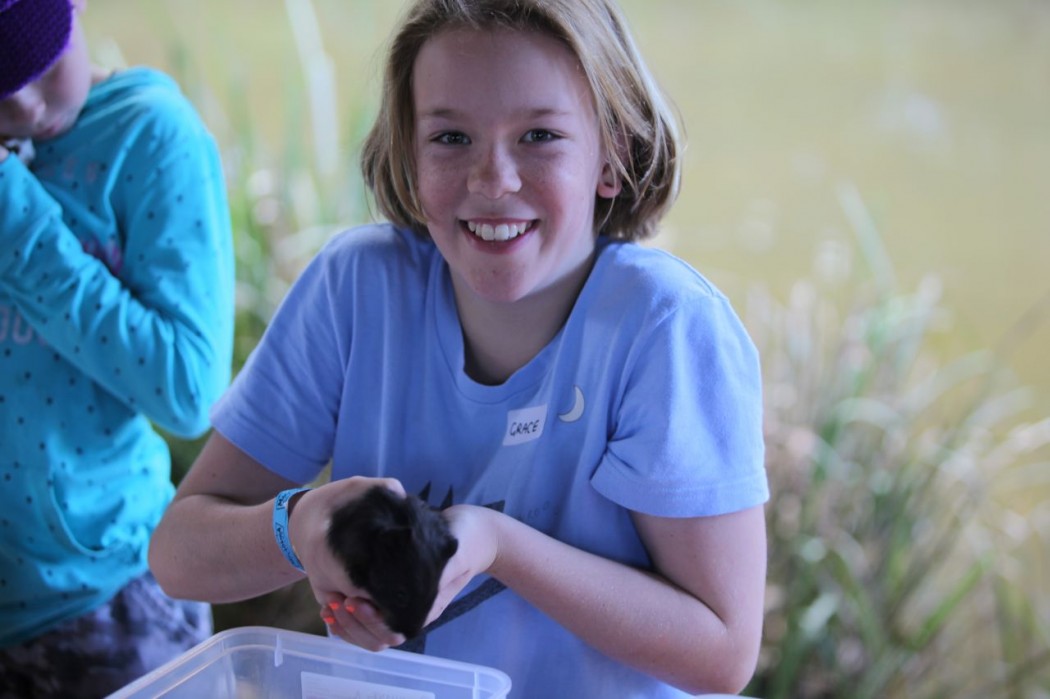

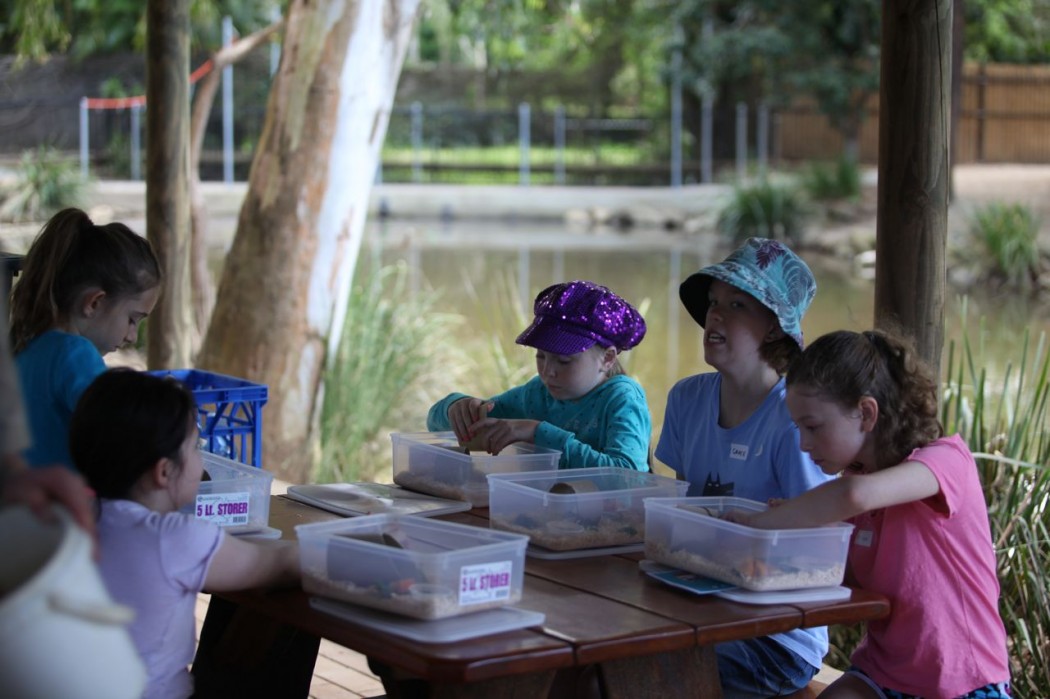
The participants in Wildlife Guardians create enrichment enclosures for their guineapigs under the watchful eye of Keeper Georgia Shapter.
Also (and I can already hear the cries of disbelief, but it’s true), I never knew – or more correctly had never stopped to think about the fact – that kangaroos and emus can’t walk backwards, and this is why they’re on our Coat of Arms, because Australia must go forward, which of course suddenly makes much more sense of Advance Australia Fair, the anthem to which none of us can ever remember the words. (Well, at least I can’t.)
I’m in the company of senior keeper Georgia Shapter, who is in charge of the young Wildlife Guardians holiday workshop, and the next day’s Keeper for a Day. Georgia, who has worked at the Castle for 15 years, knows all the animals by heart. (And for those of you who may have wondered if Elvis the blind goat had passed away – he’s living his life out on a property and is still very much alive.)
The young Wildlife Guardians had a ball creating ‘enrichment’ enclosures for their guinea pigs, with cardboard tubes, fresh sawdust and food, and lots of behavioural comparisons. The wombat’s life was also very much enriched by the hiding of parcels of fresh corn in her enclosure, and by the time she’d finally worked out where they all were, it was time for some alpaca behavioural training, because, said Georgia, he’d developed a dislike of the keepers in their uniforms, although he was very friendly towards the visitors.
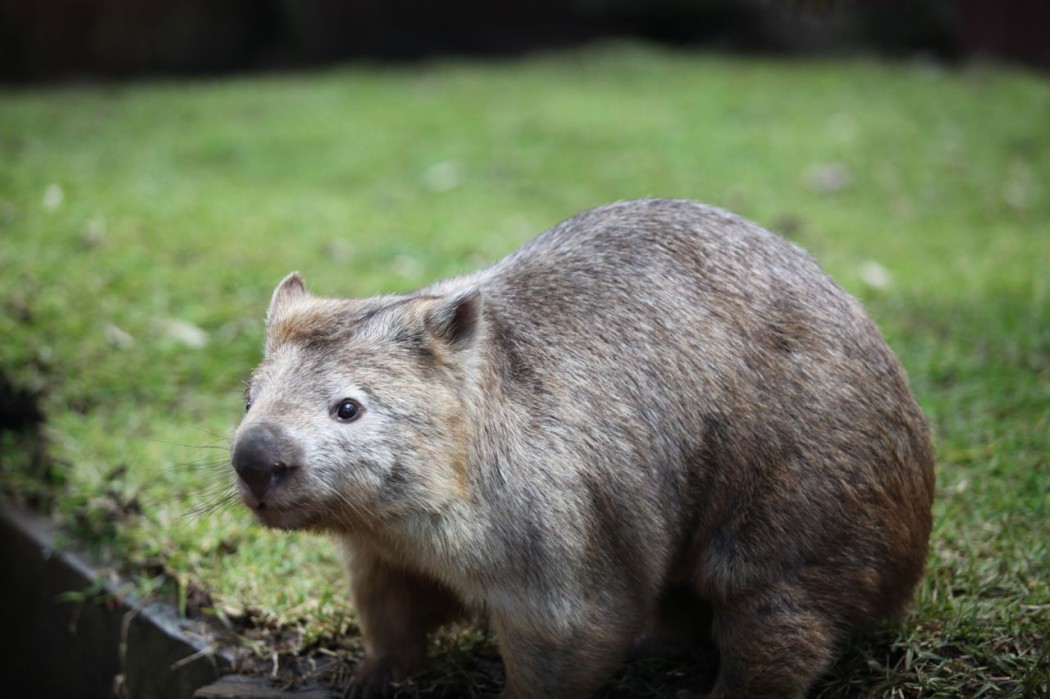
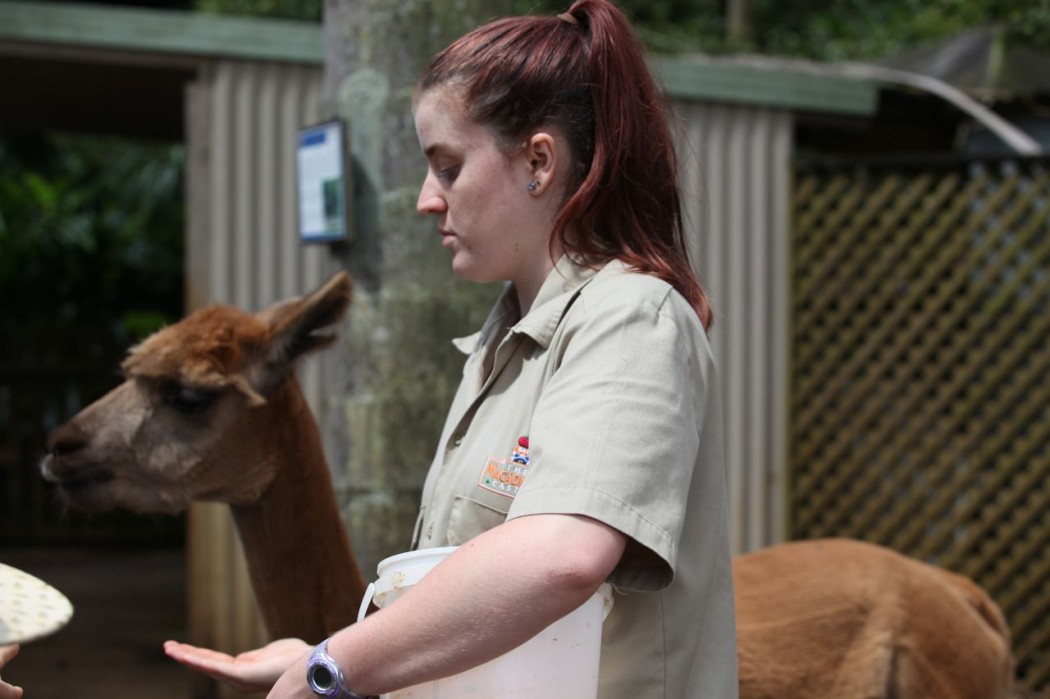
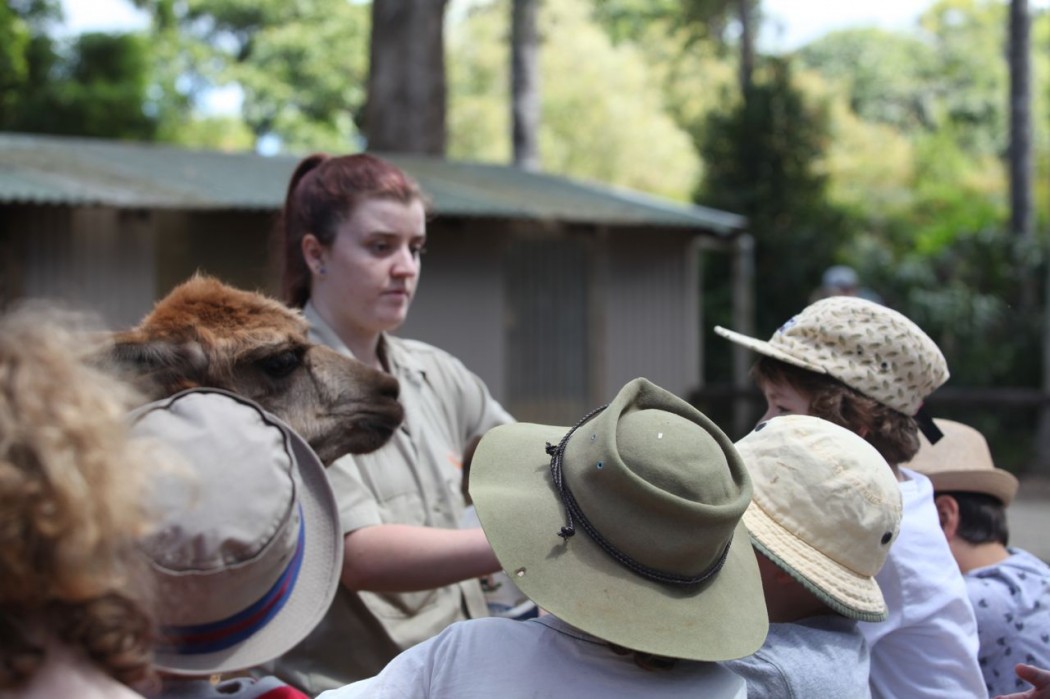
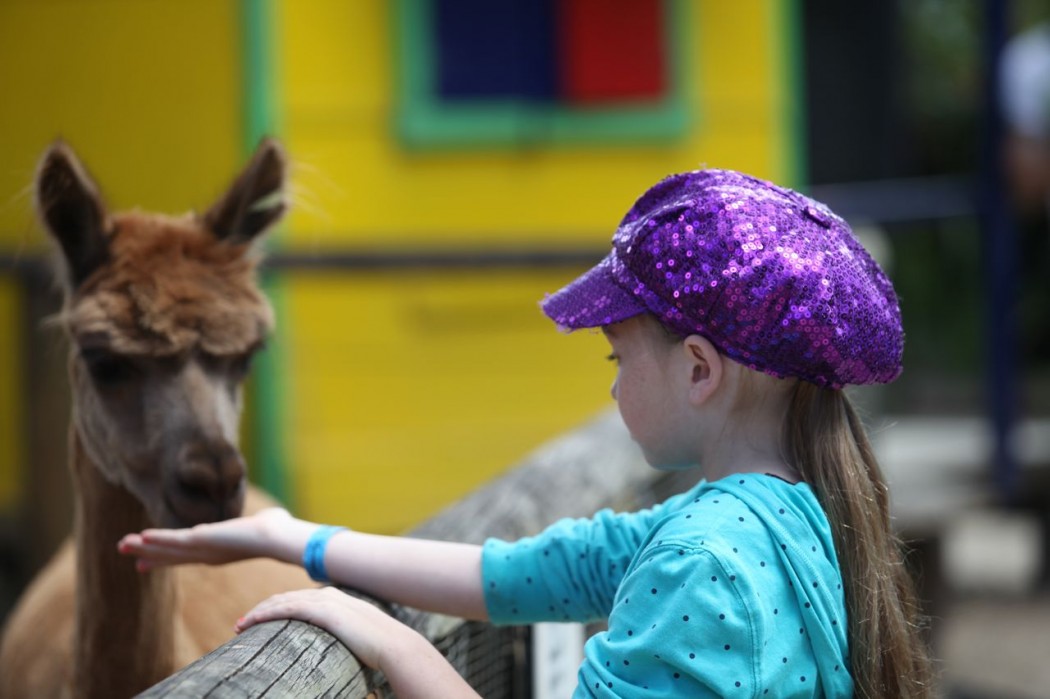
“It’s because we have to put tick collars on him,” she told me, “and also we have to shear him, which he isn’t very keen on.” The behavioural training was designed to reintroduce him to the idea that the keepers could be nice too! “We just want him to realise that we come with treats,” she said, a touch sadly.
The next day the young keepers-in-training learned some of the harder facts of life – that, for instance, 80% of a keeper’s job, is clearing up animal poo. The kind of fact that is going to quickly weed out the animal lovers from those who really want a career in animal care. Being older, they were able to help with food preparation and to have a greater interaction with the animals.



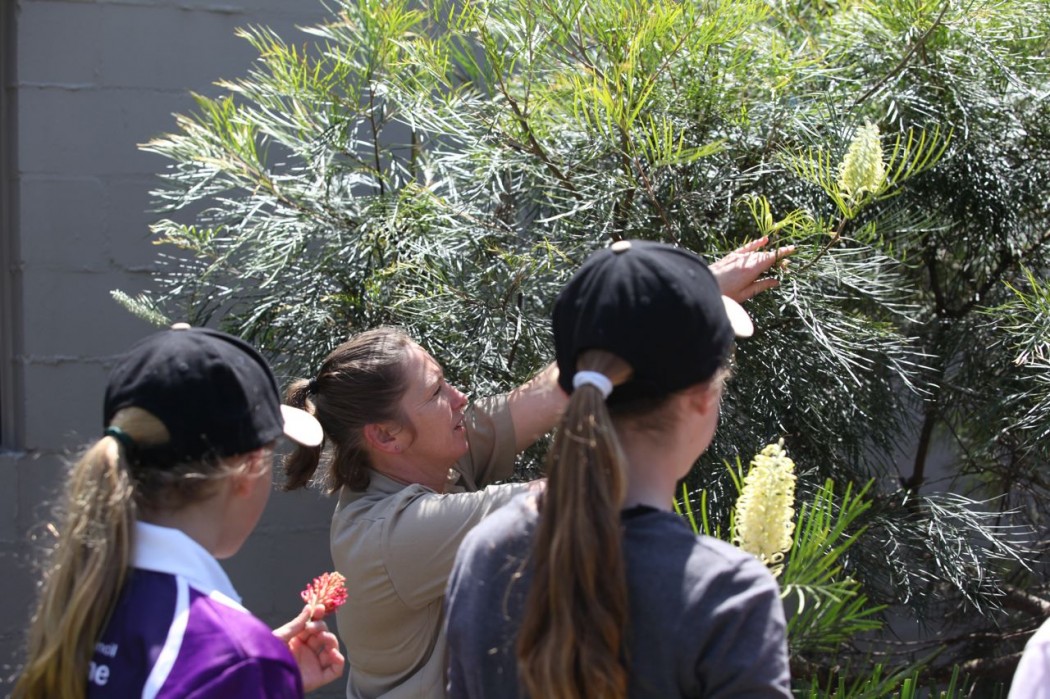
“We’ve been thrilled with the fact that quite a few kids who’ve done Keeper for a Day have then made a choice to go on and work in the industry,” said Georgia.
Without a doubt, the whole group said, their favourite place was the aviary, where they were able to go to town with their interior decorating skills, placing grevillea and bottle brush blossoms so that the parrots could indulge their sweet tooth.
What they’d learnt, which had surprised them, was how carefully sterilized all the bottles and feeding equipment for the baby animals had to be. “We have to take every precaution with the babies,” Georgia explained. “Particularly because many of them have been orphaned and they don’t have the same immunity they would have if they were in the wild with their mothers.”
Of course, while the workshops were going on, the everyday business of the Castle was underway as well – and being the holidays it was in full swing, but these workshops are part of a new initiative towards education that the Macadamia Castle management are exploring.
“We’re surveying customers to find out what they want to see,” said Georgia, “and whether perhaps we move more towards being a native animal park so that we can better educate Australians – and visitors to Australia about the amazing wildlife we have right here on our doorstep.”
The Macadamia Castle, along with the kangaroo and the emu, is marching forward, although I’m sure the massive knight-at-arms who still colourfully guards the entrance, isn’t going anywhere in a hurry.
Photographs and text by Candida Baker
For more information on holiday workshops or general information call the Macadamia Castle on 6687 8432 or go to macadamiacastle
The Macadamia Castle is open seven days a week, 8.00 am to 5.00 pm. Workshops take place during the holidays and there are limited numbers of places.
The post Education (and fun) at the magical Macadamia Castle appeared first on .
]]>The post For the love of a good caravan appeared first on .
]]>Sharon’s our big old retro Chesney Caravan who has also been known to go by ‘Shazza’. She was a gift from our good friends Big Tone and the Pineapple Princess.
I should explain that even though Dave was originally excited by my good news that we’d received such a lavish gift he was less than enamored when he actually got his first glimpse of Sharon. (In her prime, she’d once been a haven of solitude and inspiration to many a famous muso, and although she’s never been one to brag she’s even sheltered the famous Kelly gang – well Paul and Dan anyway.) Dave had visions of a glamorous curvy vintage caravan but Shazza was not exactly a picture of beauty! In fact, when we first saw her she was covered in slime and moss and with a tree growing directly out of her roof. To be honest big fat square Sharon gave off an air of quiet desperation.
Before we could even start with the renovations I had to perform a touch of amateur arboreal gymnastics – which entailed a lot of laughter from a helpfully watching crew. But then our Sharon was on the road to restoration and Dave’s initial hesitation turned to a passionate love affair as he scrubbed, scraped and painted every surface that Sharon had to offer.
No sooner were we done with Sharon’s makeover and it was time for our big move north to Murwillumbah to follow our sub-tropical dream. Sharon, wondering what she had done to offend, was left behind, until Dave went back to retrieve our home on wheels. I had to be left out of the 4000 kilometre return journey, so I planned to fly to Newcastle and join them on the return journey. Unfortunately a bush fire caused a major diversion for Dave, our dog Thelma Louise and Sharon and it was arranged that I would meet up with them in Yamba. I had to travel a good 120 kilometres alone! Due to their diversion it transpired that they rejoined the highway in front of me, traveling north – and then of course I spotted them! I must admit I was a little taken aback when Dave only scowled at me as I sailed gaily by, waving and tooting! Boy 4000 kilometres can really put a dent in someone’s sense of humour!
So there we are. Sharon is now officially a resident of Northern NSW and has even enjoyed a trip to Nimbin, and as I’m writing this we are traveling home from a truly delightful stay in Sapphire Beach just north of Coffs Harbour. Under the shade of the mighty paperbarks and only metres from a sapphire blue ocean we laughed, drank, read and ate to our hearts content.
The ocean was brisk but delightful and Thelma Louise and I frolicked like teenagers…albeit a creaky one, while Dave declined the offer to immerse himself in freezing cold water. Dining out was superb, as was checking out the delights of Bellingen and all its splendid craft.
We returned restored and inspired. And the moral of the story is – there is no moral…who needs them? All I can say is If you find life is getting you down, look for the simple pleasures and enjoy!
You can read more about Pete’s adventures and also see his art on: petegoodlet.com
The post For the love of a good caravan appeared first on .
]]>The post Beach, rainforest, food and sunrises – what’s not to love? appeared first on .
]]>Ahhh Byron Bay! What a unique and wonderful place, the best kind for a week away. If you follow me on Instagram, you’ll know I was recently in Byron Bay and you’ll also know that I absolutely loved it. Beach, rainforest, mountains and beautiful sunsets, all at the same time, how could one not fall in love?
But that’s not what drew Robbie and I to Byron for our getaway. It all played a part, of course, but it was really the food that drew us there. And for very good reason.
Byron Bay and its surrounds are dotted with foodie gems. We were spoilt for choice for cafes and restaurants that offer gluten free, dairy free, vegan, nut free, and you-name-it dietary options, making it extremely easy for us fructose malabsorpers and the like to eat out. As you can imagine this was a highlight since I felt I could freely eat out almost anywhere. A few of my faves included the ridiculously good vegan smoothies at Naked Treaties, the delicious vegetarian nourish bowl at The Roadhouse, the Hare Krishna green curry at The Cardamom Pod, a proper good avo smash at Folk and some amazing brunches and coffee at Bayleaf. So so good!
The food adventures did not stop there though. A prerequisite for our accommodation is always a full-size kitchen. I love having the option to stay in and cook, and rightfully so because the fresh local produce in Byron Bay was pumping! The weekly farmers market located just on the side of the town centre had everything we needed. And that’s where the magic really began. Especially when we found what we now refer to as the magical pineapple! The most deliciously sweet pineapple I’ve ever had and it only cost $2!
The foodie surprises continued when our overwhelmingly generous hosts surprised us with a delivery of a big container full of shelled pecans and an even bigger bag packed full of a variety of fresh herbs. We were pretty much in heaven.
With all this amazing fresh produce at our fingertips, I couldn’t help but get experimenting in the kitchen. An amazingly sweet and juicy pineapple and a heap of pecans… the answer was waiting in a fresh, hot batch of gluten free Hummingbird Pancakes made with buckwheat flour – definitely too good not to share!!
Food aside, Byron Bay was just a super cool place with plenty to keep us happy. If I had to offer my top three things to do in Byron, it would be eat, hike, and watch the sunrise and sunset. One morning we were up before the sun so we could run to the Lighthouse for the best vantage point to watch the sun hit the most Eastern point of Australia. Another day we drove inland through the Hinterland to the edge of Mount Warning for a hike that would leave my legs sore for days. With an almost vertical incline for the last 250 metres to reach the summit, it was a truly amazing experience… Luckily we had these pancakes on return to keep us going!
So there you have it, a few ideas for your next getaway and a damn good pancake recipe to enjoy.
Hummingbird Pancakes
Serves 2
1 cup milk of choice
1 tsp apple cider vinegar
1 cup buckwheat flour
1 tsp baking powder
1 tsp cinnamon
Pinch of salt
1/2 banana, mashed
1 egg
Pineapple
Pecans
Banana
Natural yoghurt
Measure out milk, add the apple cider vinegar and set aside to ‘sour’. Combine all dry ingredients together in a large bowl. Mash banana in a small bowl, whisk in egg and soured milk. Add wet mixture to the dry, and mix well. Set aside for five minutes while you prepare some toppings. Place pineapple slices in a fry pan on medium heat to caramelise. You may also add the pecans to toast. Heat another fry pan on medium heat and begin cooking the pancakes – keeping an eye on the pineapple and pecans at the same time. Serve pancakes with caramelised pineapple, toasted pecans, fresh banana and a dollop of natural yoghurt. Enjoy!
Find out more about Stephanie Papillo and the Friendly Little Kitchen on:
The post Beach, rainforest, food and sunrises – what’s not to love? appeared first on .
]]>

